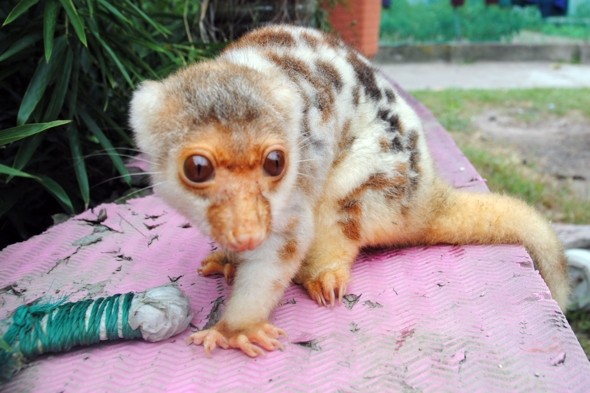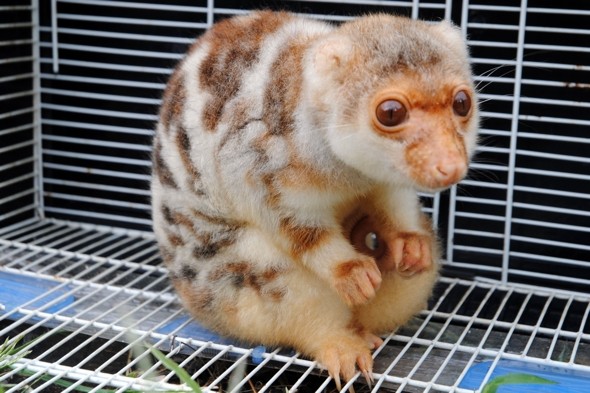New Chinese “What-Is-It?”
Posted by: Loren Coleman on September 24th, 2011
Mysterious cryptids are part of the passion of the press, sometimes even in Asia.

China merchants have a new creature in a cage. Remember the “Oriental Yeti” that turned out to be a civet? Well, this new animal’s photos are appearing on the web.
I know what it is, but would you like to have some weekend fun?
Identify this species in comments below, and I’ll post some answers after ten or so entries show up.

Thanks to Tojo Melville for the newstip.
About Loren Coleman
Loren Coleman is one of the world’s leading cryptozoologists, some say “the” leading living cryptozoologist. Certainly, he is acknowledged as the current living American researcher and writer who has most popularized cryptozoology in the late 20th and early 21st centuries.
Starting his fieldwork and investigations in 1960, after traveling and trekking extensively in pursuit of cryptozoological mysteries, Coleman began writing to share his experiences in 1969. An honorary member of Ivan T. Sanderson’s Society for the Investigation of the Unexplained in the 1970s, Coleman has been bestowed with similar honorary memberships of the North Idaho College Cryptozoology Club in 1983, and in subsequent years, that of the British Columbia Scientific Cryptozoology Club, CryptoSafari International, and other international organizations. He was also a Life Member and Benefactor of the International Society of Cryptozoology (now-defunct).
Loren Coleman’s daily blog, as a member of the Cryptomundo Team, served as an ongoing avenue of communication for the ever-growing body of cryptozoo news from 2005 through 2013. He returned as an infrequent contributor beginning Halloween week of 2015.
Coleman is the founder in 2003, and current director of the International Cryptozoology Museum in Portland, Maine.










My vote is on a Slow Loris.
It is one of the Spilocuscus species, probably Spilocuscus maculatus which is highly variable in colouration and pattern.
it’s a cuscus
I think this is a Spotted Cuscus…
really don’t know? it’s cool looking. what’s in a name anyway?
For me it’s a beautiful young common spotted cuscus (Spilocuscus maculatus) 🙂
Panic over Loren, it’s simply a cuscus.
http://en.wikipedia.org/wiki/Cuscus
That’s tough. Best clue to me is it’s tail, which seems either prehensile or nearly prehensile. A google search didn’t yield anything too convincing.
Best I’ve been able to come up with so far is a spotty baby kinkajou… but not convinced of that. Or perhaps a spotty lemuroid possum.
It seems to be a juvenile Spotted Cuscus (Spilocuscus maculatus or Phalanger maculatus).
Word!! 🙂
Looks marsupial… Kinda looks like Spilocuscus (http://www.visualphotos.com/photo/1×9095112/short-tailed_spotted_cuscus_spilocuscus_maculatus_590126.jpg)
The creature in the photos looks like it is some type of lemur.
I’ll tell you what it is. Adorable! …..
and a cuscus.
I’d have to throw my hat in the ring with those identifying the “What-is-it” as a juvenile/malnourished(?) Common Spotted Cuscus, “Spilocuscus maculatus.”
Endemic to extreme northeastern Australia, New Guinea and nearby smaller islands, the Common Spotted Cuscus, a marsupial, attains an adult weight of 12 lbs and length of 48″, half of which consists of a prehensile tail. Generally nocturnal they are omnivorous eating: leaves, fruits, flowers, small animals, and occasionally eggs. Their major predators are pythons and larger birds of prey.
It is most definitely, a spotted cuscus.
Well, what ever it is, I’m sure the locals want to know what it tastes like fried in some sweet and sour sauce! Very cute little critter! I just hope him or his family never end up in an egg roll!
“Identify this species in comments below, and I’ll post some answers after ten or so entries show up.”
– Loren Coleman.
Well, Loren, out with it. General consensus (9/14) seems to be a Common Spotted Cuscus. So, what exactly is the “What-Is-It?”
It is a Cuscus. Have handled these guys in captivity (licensed animals). Very sweet, generally slow moving, very waxy feeling fur – but then they’re from Oz/Papau and New Guinea rainforests so they need the waterproofing.